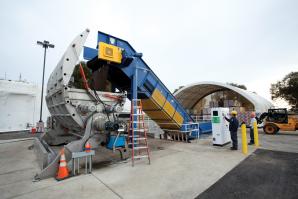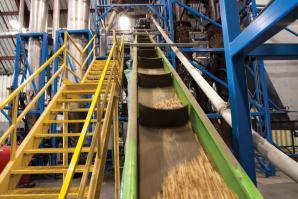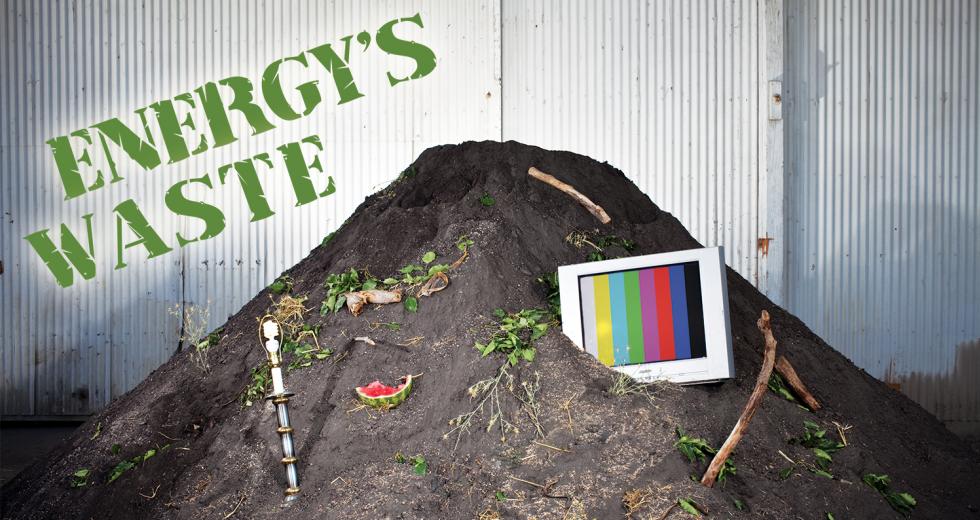Smaller landfills, fewer forest fires and more renewable energy — these are just a few perks California would get from increasing biomass energy, some experts say. All the business community needs to do is secure financing in the worst economy since the Great Depression, find a few lawyers to help navigate through expensive and time-consuming regulations, and dump money into ever-changing technology.
Biomass has several definitions. Essentially it’s waste from organic materials — forest residues, animal waste, agricultural residue and some landfill solids — and it can be used to generate energy.
Anyone with business sense might ask why scientists and startups pursue biomass as an energy source with so many barriers to the market. And yet, there’s opportunity: The state wants to require 33 percent of retail energy sold in California to come from renewable sources by the end of the decade, and researchers at UC Davis estimate that more than 30 million tons of feedstock are available in California each year for biomass energy, fuel production and other industrial uses.
“The market will drive more biomass in the coming years because the [feedstock] is sitting there, and there’s a bigger market for it. To what extent, I don’t know because we haven’t crunched the numbers,” says Greg Tamblyn, executive director of the Renewable Energy Institute International based at McClellan Business Park. REII is working on several federally funded bioenergy and biofuel projects.
Last year Gov. Arnold Schwarzenegger vetoed a bill mandating a 33 percent renewable energy portfolio by 2020. The bill didn’t address red tape that would make the standard difficult to achieve, nor did it include public power agencies. It was supposed to build on a 20 percent mandate by 2010, which many power agencies are not expected to achieve this year. Instead, Schwarzenegger signed an executive order in September asking the California Air Resources Board to draft and vote on a 33 percent target, expanding it to public power agencies and shifting oversight from the Public Utilities Commission to the ARB. In yet another twist, Schwarzenegger sent a letter to ARB chairman Mary Nichols last month asking the board to delay action, so he can negotiate a more business-friendly bill with lawmakers.
“The bill failed to include any measures to streamline California’s complicated and overlapping permit process without which we may not be able to meet a 33 percent standard,” Schwarzenegger said in his July 15 letter.
Across town from the Capitol, the Sacramento Municipal Utility District is bucking the trend set by the rest of California. The public power agency expects 23 percent of its power to come from renewable sources in 2010, beating the state’s goals. California as a whole generated only 14 percent from renewable sources in 2009, according to the state Energy Commission.
And biomass is at the forefront of SMUD’s renewable arsenal. The agency expects to generate 2,600 gigawatt-hours of renewable energy in 2010, with 61 percent of it from biomass. By comparison, biomass comprised only 20 percent of the renewable energy mix for California in 2009.
“SMUD has a very aggressive goal for renewable portfolio standards,” says Valentino Tiangco, who works with advanced, renewable and distributed generation technologies for the utility.
SMUD uses a mix of combustion, landfill gas, wastewater to digest gas, and dairy biogas systems. However, nearly three-quarters of its biomass comes from solid waste, such as debris from construction, vineyard pruning and forest and agricultural residue.
Although many power agencies aren’t expected to meet state goals this year, a March 2008 report estimated 32 million tons of biomass per year was available on a sustainable basis in 2007 for electricity generation and biofuels production, according to the California Energy Commission. That number is expected to grow to 40 million tons by 2020.
The biggest challenge, however, might be the competition for feedstock between bioenergy and biofuel. “This is a global question, and whether the industry is going to be able to meet sustainability standards for feedstock productions, especially in fuels,” says Bryan Jenkins, professor of biological and agricultural engineering and director of the UC Davis Energy Institute. As the Western world tries to wean itself from fossil fuels, more demand for biofuels could decrease the supply of bioenergy. The state is drafting a report that examines the competition.
Bioenergy will increase, but slowly, says Mark Pawlicki, director of corporate affairs and sustainability for Sierra Pacific Industries. The forest products company operates six co-generation plants in California and two in Washington to dry lumber in kilns and create energy. Combined, it sells about 100 megawatt-hours to the states’ grids.
“Environmental activists regularly sue the U.S. Forest Service and private landowners to stop timber sales and forest thinning projects,” Pawlicki says. “These lawsuits cause delays and add costs to production.”
While biomass will produce more megawatts, it won’t keep up with other renewable sources in California, says Paul Sicurezza, manager of biomass project development with WorleyParsons in Vancouver, Wa. Solar and wind projects will produce hundreds of megawatt-hours, he says. “The largest biomass facilities generally are in the 30- to 50-megawatt range, but the majority of those that will be permitted will likely be based on sources such as landfill gas and anaerobic digestion, which offer much smaller capacities of 1 to 25 megawatts per facility,” he says.
Each type of renewable energy project comes with its own environmental challenges, says Barbara Brenner, a partner with law firm Stoel Rives LLP in Sacramento. “Solar and wind projects are species-driven,” she says, “so you have to look at the habitats around them. With biomass you’re looking at bringing [the feedstock] to the facility, so there is fuel consumption, emissions from the stack and where to put the water waste.”
There also are too many regulatory agencies, “and they will stop each other from doing things because they can’t all agree on what biomass is,” says Chris Schuring, the COO and co-founder of Ternion Bio Industries, which helps independent power producers with renewable energy, including algae-based systems.
Ternion conducts its research and development at McClellan Business Park. However, only 3 percent of its clients are in California. “It’s easier to do business in the international market because you just have to deal with one or two people,” Schuring says. “I can call up Brazil and get an appointment with the guy who heads up the utilities in Brazil. Try doing that here.”
If it does little business in California, why is Ternion based here? “Because we live here,” Schuring says.
And he’s not the only Capital Region biomass company looking mostly overseas. Davis-based Sierra Energy Corp. is also working on technology at McClellan that turns waste into energy using gasification, not traditional combustion. Sierra Energy could license the technology to more than a dozen power producers worldwide next year, according to Michael Hart, president and CEO. The key feedstock for Hart is municipal trash.
Every ton of waste that is gasified saves the world from more than 22 tons of greenhouse gases that would be produced if the waste were placed in a landfill, according to Hart. “Bear in mind that biomass is an immense source of material,” he says. “You’ve got municipal solid waste, which is the largest source of feedstock in California. Los Angeles County alone puts 20,000 tons of solid waste into a hole in the ground each day. It dwarfs the amount of emissions they are putting into the atmosphere from cars.”
Take Sacramento County, for example. Assuming it collects 3,000 tons of trash per day and builds a gasifier for $108 million, the county could net $119 million per year plus the market price for its carbon credits.
This year the California Energy Commission is updating its Bioenergy Action Plan, which outlines bioenergy and biofuel goals for the state. It also identifies barriers, such as project financing and regulatory hurdles.
But the commission and other agencies are also working on solutions, says Sarah Michael, adviser to Jim Boyd, vice chair of the commission’s Renewables Committee. Several state agencies and local air districts recently came together to draft a model for environmental permitting of dairy digesters. Navigating through approvals for several state agencies can be daunting for a dairy farmer, Michael says. The model is going through hearings this month in Fresno and Rancho Cordova and is in the final stages of consideration. The commission and other agencies are also in talks to create a one-stop shop for biomass projects in the state.
Sometimes the tough environmental regulations can make equipment — and technology — expensive. For example, SMUD is asking dairy farmers to install digesters to create biogas, but the investment is too much for some who have battled plunging milk prices the past few years.
At McClellan Dennis Schuetzle of REII is working on several federally funded projects to make bioenergy and biofuel. Most bioenergy projects aren’t viable unless there is a fuel component, Schuetzle and Tamblyn say, because the market price of fuel is much higher than energy.
“It’s really important to make sure the technology works. If the technology works, the money will follow,” Schuetzle says.
Waste usually comes from within a 30- to 50-mile radius, Tamblyn says. The cost to collect, transport and store agricultural residue for bioenergy ranges from $25 to $50 per dry ton, according to UC Davis researchers. Biomass from forest thinning can cost $30 to $50 per ton at roadside, but an additional 20 cents to 60 cents per mile per ton to deliver to the conversion point.
According to Schuetzle, biochemical conversion, which uses fermentation or anaerobic digestion, is less practical than using heat, or thermochemical conversion. Biochemical needs a different enzyme for each feedstock, he says.
“Biofuels from algae, for example, take a tremendous amount of water, which would be a problem in California,” Schuetzle says.
Schuring disagrees, noting that much of the water gets reused. “The algae process has the opportunity to use wastewater and recover 65 percent of it,” he says.
At Sierra Energy, Hart says he is perfecting his gasification technology so that it makes financial sense. “That’s the problem when people talk about biomass. It’s that scientists aren’t economists,” Hart says. “They spend years trying to turn rice straw into energy or burn down woody waste to ethanol. The day they succeed is the day they put themselves out of business.”
The reason, Hart says, is that scientists create a commodity when they discover a new feedstock. “If farmers can sell their rice straw, they will. They aren’t stupid,” Hart says. “Scientists assume they are going to get free feedstock. Every one of these technologies is cursed.”
Hart says his assumptions take into account paying for municipal waste — eventually. “We have the only technology where we can afford to buy trash,” Hart says. “We’re not going to do it until we have to; I mean, we’re not stupid.”
With all of these technologies still in development, much of the funding is coming from government grants and personal funds. “It’s harder to fund emerging technologies than it is proven technologies,” Tamblyn says.
Lenders want to cut their risk as much as possible, Sicurezza says. “While there is interest in the financing community to support biomass, they are demanding a high degree of certainty in the project’s predicted technical and financial performance,” he says. “This requires a significant amount of front-end engineering to be completed, which is all done at the risk of the developer.
“The cost for this work can be as high as $2 million to $5 million before they have a sufficiently defined project with all of the required permits to satisfy the lending community,” Sicurezza says.
Even with all of biomass’s opportunities and challenges, science still has a lot to learn about the indirect effects of biomass technologies, Jenkins says. “The European Union and other countries are trying to understand the global impact,” Jenkins says. “We need to do additional research to reduce cost and reduce emissions.”
Recommended For You

Heater’s Digest
Organic waste to renewable energy gains traction
Children now have logical reasons for not finishing their brussels sprouts at the dinner table. If they’re thrown away, it could be good for the economy and the environment.

Green Gas Grows
Capital Region biofuels reek of potential
A 2009 report from Pike Research in Boulder, Colo., forecasts the combined biodiesel and ethanol markets will reach $247 billion in sales by 2020, up from just $76 billion in 2010, or about 12 percent annual growth.



